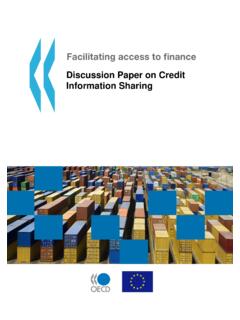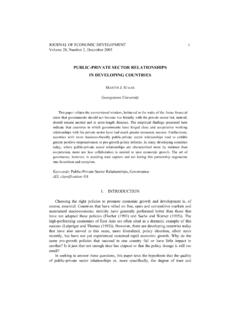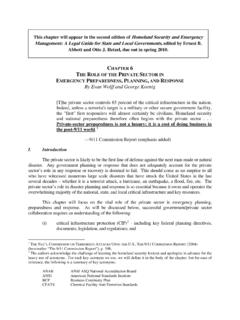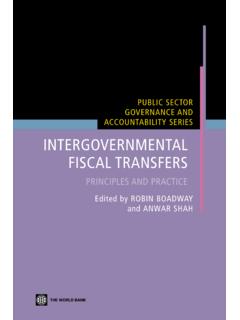Transcription of Can Financial Incentive Influence Medical Practice - WHO
1 Original Articles Can Financial Incentive Influence Medical Practice ? Mireille Kingma, PhD Consultant, Nursing and Health Policy International Council of Nurses Geneva, Switzerland Abstract Background: Economic policy determines the allocation of funds and provides the framework within which health services are initiated, maintained or abandoned. Its implementation introduces Financial incentives /disincentives likely to Influence the attitudes and/or conduct of the people involved. The literature review presented in this article documents the existence of personal Financial interest as a factor in the clinical decision-making of Medical personnel. Findings:. Allocated payments (including merit pay and profit sharing) appear to shift doctors Practice to meet targets ( population coverage, reduced spending) while generating possible perverse effects ( emphasis on quantity vs. quality). Remuneration strategies ( capitation, shared Financial risk, fee-for-service and salary systems) alter spending patterns, interrelationships, Medical protocols, work codes and statistical recording.
2 Conclusions: The choice of payment mechanisms is not a neutral decision and has significant policy and Practice implications. The extent to which these factors Influence care patterns depends on the interplay of Financial incentives /disincentives, urgency of patient need and the doctor s value system. Key words: Financial Incentive , remuneration, doctor, physician, gain, motivation. Can Financial incentives Influence Medical Practice ? Organisations have been described as fascinating collections of people. The challenge is to make them productive and useful communities. That requires the use of power in its many (1). The decision-making process that determines the distribution of assets, including Financial resources, is part of the power structure of systems, organisations and enterprises. It is hard to imagine any period in time when economic issues were more visible in health sector decision-making.
3 The search for measures that maximize available resources has never been greater than within the present decade. A staff paybill often represents 60 - 70% of budgeted health service funds (2). The cost-effective utilization of human resources is thus an objective of paramount importance. Using economic incentives and disincentives to direct individuals energies and behaviour is common Practice in all work settings, of which the health care system is no exception. While money may not appear in the literature as a critical human need, it is often assumed as instrumental in satisfying each and every one of the needs, from hunger to self-actualization (1). This article summarises a literature review undertaken to identify Financial incentives /disincentives (including remuneration strategies) relevant to Medical personnel ( doctors), looking at their objectives and documented outcomes. Three 2major data base systems were used: Silver Platter (MEDLINE EXPRESS (r), Health STAR and Bath Information and Data Services (Social Sciences Citation Index, Science Citation Index, Social Sciences).)
4 The key words introduced during the search were Financial incentives , wage Incentive , physicians/ incentives , gain, motivation, remuneration, fee-for-service, reimbursement, payment. Library searches were also undertaken at the International Labour Organization, London School of Hygiene and Tropical Medicine and the Royal College of Nursing. Research demonstrates that while doctors remuneration accounted for less than 25 per cent of health care costs, their decisions were responsible for 70-80 per cent of expenditure on treatment (3). How these funds are allocated and the value of consequent outcomes are therefore of primary interest in the present climate of health sector reform. A clearer understanding of factors influencing doctors judgement may facilitate the development of a more effective management of Financial and human resources within the health sector. Background The idealised image of Medical personnel in many countries has traditionally been the independent altruist, devoted and striving for the good of the patient(4).
5 Payment for services was generally negotiated privately between the doctor and the patient and rarely regulated by anyone outside this restricted relationship. The growing number of doctors in salaried positions and the transition to third party reimbursement ( social/private health insurance) introduced a variety of interested persons into the remuneration negotiation process. Representatives from government, insurance companies, professional associations, unions and consumer groups were increasingly involved. The potential for political manipulation of Medical Practice became apparent and the balance of power between the various social groups was recognised as one of the determining factors shaping the provision of Medical care (2, 5). Due to the doctors pivotal role in the health sector as the major gatekeeper for services ( coordinating patients care throughout the Medical care system (6)), any Influence exerted on their function has significant ramifications for the entire health system.
6 In parallel, changes in the financing of Medical care strongly affects the employment outlook for doctors(3). The choice and implementation of remuneration and reward policies are increasingly recognised as affecting the delivery of health care. As yet however, the literature provides few data on their impact on the quality of care(7). The aspect of quality is beyond the scope of this article. The primary step of identifying effective rewards ( having an impact on behaviour) will however reinforce the knowledge base needed to support the delivery of improved quality health care in the future. Policies Affecting Income Many economic policies1 have a direct impact on doctors income. Within these policies, decision-makers have three options, the introduction of either rewards or penalties to the present system, or both. The majority of these measures relate to actual payments of some kind: a) allocating (or increasing) payment, or b) withdrawing payment for a specific service.
7 This category of payment represents a complementary source of income, in addition to the applied remuneration strategy which provides the major source of income (see below). 1 Any course of action adopted by the authorities ( government, employer, unit supervisor) requiring an investment or reallocation of funds. 3 Allocate Payments Figure 1 Allocated Payments RecruitmentProfitsharingWithdrawnTargetS pecialMeritAALLOCATED PAYMENTS In general, providing earmarked payments is used as a means for increasing or improving health service coverage. Target Payments Target payments reward the provision of a specified percentage of the population with a particular clinical intervention, screening, immunisation. In the UK, the introduction of target payments for cervical screening is a Financial Incentive offered to General Practitioners (GPs).
8 A lump sum bonus is allocated to those who achieve 50% coverage of their eligible population. An even higher payment is obtained if an 80% coverage is reached. The strategy s effectiveness was demonstrated when researchers found a 50% increase in the number of cervical cytologies carried out by GPs when compared to the level forecast for the year under study(8). Target payments, as all Financial incentives , often generate unwelcome results or perverse effects as well as the desired impact. The allocation of target payments for preventive screening measures may have the effect of concentrating the GP s time on throughput and procedure ( Pap smear). Opportunities to assess health needs and develop relevant health promotion strategies could be lost. When payment focuses on quantity and not quality of outcome, there may be actual disincentives to talking with patients(9).
9 Components of preventive care may be carried out but the required follow-up measures could be weakened by these short term, one-off approaches. Moreover, Financial incentives [in the UK] are only linked to information about patients, not to health promotion activity or, more importantly, to the outcome of that activity (10). If targets are set unreasonably high, or the intervals between targets are not calculated correctly, target payments may ironically become disincentives. Furthermore, once the highest target is reached ( 80%), there is no additional Financial reward to cover the remaining eligible population. 4 Special Payments Special payments are linked with various patient populations. These attempt to recognise any additional GP workload involved as well as encourage improved coverage of a targeted group. Examples in the UK include increased capitation payments for the population aged over 75 and under 5, and newly registered patients.
10 Deprivation (deprived area) payments have been used to encourage doctors to care for patients from marginalised urban areas in the UK, government subsidised poor populations in the US, as well as isolated rural areas in Norway(11-13). Certain authors however question the basis for such payments. Carr-Hill et al specifically refer to the lack of evidence that patients from deprived areas actually represent an increased GP workload(11). They go on to critique the tool used to determine which areas are to be considered deprived while noting that these payments may result in perverse incentives to increase list size with no guarantee that care will improve or consultation time will increase. Many countries pay special allowances for staff working in hazardous or arduous conditions(3). Caring for patients suffering from a disease stigmatised by society has in certain systems justified special payments, mental illness, while in others, lower pay scales have been a disincentive imposed on personnel working with these target populations(14).
















